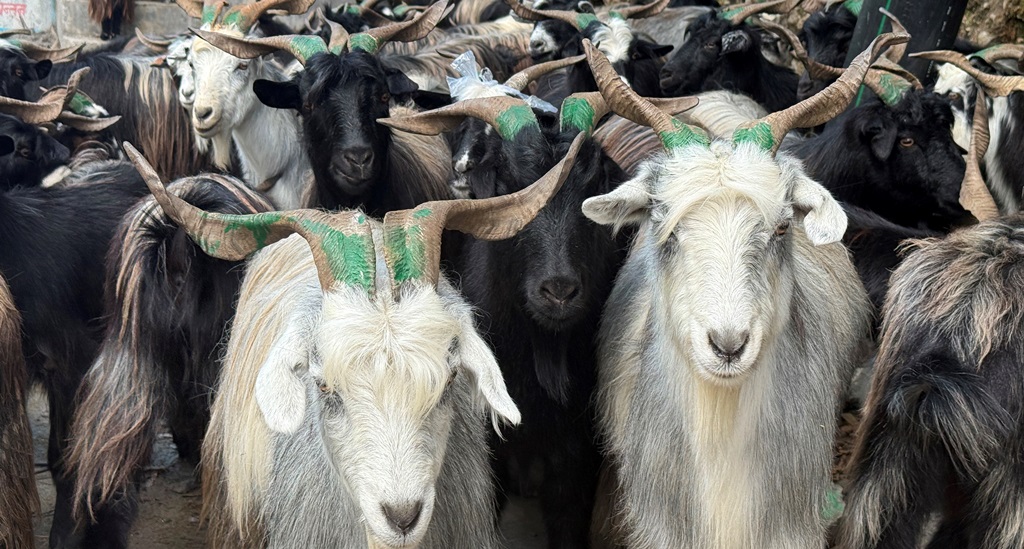Kathmandu, 30 Sep: Farmers in Lo-Ghekar Damodarkunda, Mustang, are reporting a significant shift in the market for *chyangra* (Himalayan sheep). Nima Gurung, a seasoned *chyangra* farmer, explains that while there was high demand for sheep imported from Tibet in previous years, they have fallen out of favor with consumers this season. Gurung states that after traders from Upper Mustang stopped purchasing the Tibetan sheep, local farmers like himself have also ceased buying them.
The primary reason, according to the farmers, is the inferior quality and taste of the Tibetan sheep compared to their Mustang-reared counterparts. Gurung elaborates that the sheep entering via the Korala border from Tibet’s Dongwasen area are raised deep inside sheds and fed with grains and water, unlike the Mustang sheep that graze on natural pastures. This difference in rearing practices results in the Tibetan sheep being less flavorful and, therefore, less preferred by discerning consumers. “We have stopped bringing sheep from Tibet because, given the cost involved, it’s not even profitable,” Gurung adds. Traders also point out logistical problems, noting that Tibetan sheep, having been confined for long periods, often struggle to walk when herded on foot and have difficulty integrating with local Mustang flocks.
In contrast, farmers like Angyal Gurung from Chhoser, Lo-Manthang-1, Upper Mustang, attribute the superior taste of their local sheep to key factors such as natural grazing pastures, improved sheds, and the regular administration of various vaccines. This focus on quality has bolstered their confidence. “If the border becomes more accessible, we can send Mustang’s *chyangra* to the Tibetan market,” says farmer Gurung. “Even though the Tibetan sheep are larger, their taste doesn’t compare to ours here.”
Shift to Cash Economy Spurs Local Production and Complex Trade Routes
This market shift is also rooted in a change in trade practices. Historically, a barter system was prevalent between Mustang and Tibetan traders, where Tibetans provided food grains and pashmina materials in exchange for sheep. However, in recent times, Tibetan traders have sought to conduct business on a cash-only basis. This change has prompted Mustang’s traders to become more self-reliant, leading them to expand their own pens and increase local production.

The trade routes have consequently become more complex. According to Ramesh Khadka, Chief of the Mustang Customs Office, only 550 sheep entered through the official border checkpoint this year, targeted for the Dashain festival. While locals recall much higher numbers in the past, Khadka confirms that the possibility of entry from other unofficial points in Upper Mustang is low. With Mustang traders stopping their imports from Tibet, a significant portion of the sheep now entering the region comes through other districts’ border points like Morimla in Dolpa, Hilsa in Humla, and Nakchelagna in Mugu, and are then transported via Mustang.
Dr. Lalmani Aryal, Chief of the Veterinary Hospital and Livestock Service Expert Centre in Mustang, notes an interesting trend: while there is a possibility that traders might mix sheep imported from China with those from other Karnali Province districts being exported out, investigations have found that traders consistently give priority to sheep reared in Mustang itself.
This year, a total of 7,201 sheep and 75 lambs from Mustang, along with 5,900 from Dolpa, 775 from Jumla, 500 from Mugu, and the 550 that entered from Tibet, were exported out through Mustang. The trade in *chyangra*, which are reared for 3 to 5 years in the harsh high-altitude climate above 2,500 meters and fed on herbs, is highly valued by consumers for their delicious taste and health benefits. This year, the sale of sheep in Mustang generated an estimated business of around 36.5 crore Nepalese Rupees.






















